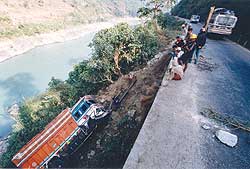 Nepal's mountains are young, its hills fragile, and its plains are densely populated. The weather swings between extremes, and when it rains, it pours. Monsoon cloudbursts, landslides, and flashfloods in the Himalaya have required civil engineering textbooks to be rewritten. To build roads in such terrain and weather is difficult enough, but to maintain them all year round is a formidable challenge. It needs budgetary, engineering and management innovations. But our record in road-building isn't all that bad.
Nepal's mountains are young, its hills fragile, and its plains are densely populated. The weather swings between extremes, and when it rains, it pours. Monsoon cloudbursts, landslides, and flashfloods in the Himalaya have required civil engineering textbooks to be rewritten. To build roads in such terrain and weather is difficult enough, but to maintain them all year round is a formidable challenge. It needs budgetary, engineering and management innovations. But our record in road-building isn't all that bad. Till a decade ago, you had to travel through India to get from Butwal to Dhangadi. After the completion of the Karnali Bridge, the far west has become easily accessible from the rest of the country.

But, it's a tragedy for our times that even as the roads have become better over the years, Indian border railheads like Siliguri, Jogbani, Jainagar, Bairgenia, Raxaul, Nanpara, Rupaidiha, Bahraich and Gauriphanta are once again teeming with Nepalis fleeing their nation to escape the insurgency.
In Nepal, the highways may be well-kept but frequent bandhs, blockades, ambushes of vehicles suspected of carrying security personnel and even arson attacks on passenger buses have made road travel perilous. Then there are all those security checks where passengers have to get off the bus with their luggage, queue up to have it rummaged through by overworked security personnel. It's becoming increasingly common for Nepali travellers to fall back once more on the Indian transport system. All those Nepalis waiting to board a train at Gorakhapur aren't headed for Tinsukia in Assam, many of them will get down on the way and head for Birgunj, Janakpur
and Biratnagar.
With better roads and less traffic, you would think Nepali highways would also be safer. But highway accidents have become so common that fatalities fewer than five don't even make headlines anymore. The reason is our road engineering does not match our vehicles and driving habits. Road design methods attempt to reduce the time, cost and discomfort of travelling from point A to point B. This entails reducing the friction between the road surface and the vehicle to the minimum possible that it is still safe. It is commonly assumed that a good road is a road with a smooth surface. Laloo Prasad Yadav in neighbouring Bihar said as much a few years ago-back from a trip abroad, he promised to build the roads in Patna as smooth as "Hema Malini's cheeks".
Institutionalised corruption in the construction industry is only partly to blame for road conditions that lead to accidents. A road system consists of fixed infrastructure (roads, parking, roadside services) and rolling stock (buses, trucks, cars). A mismatch is most visible on the Prithvi Highway where Tata trucks designed for the great Indo-Gangetic plains tumble recklessly over a road built to British standards. The highway is built for passenger comfort and the rolling stock is designed to withstand overloading. The two don't go together, and even a minor technical snag, adverse environmental condition, or a small human error can cause calamitous accidents. Clearly, we either have to re-design our highways to suit the vehicles that ply on them, or we need to begin importing Volvo buses.
Institutions that manage the system, and individuals who use it, are no less responsible for frequent accidents on our roads. Laws for road users are sketchy, their application arbitrary, violation common, and enforcement leaves a lot to be desired. A barely literate operator rushing to compete in a free-market trucking business where earnings to pay loans are directly linked to the number of hours on the road is unlikely to remember that braking at high speed can result in overturning-especially if he has just downed a couple of big ones to fight fatigue.
Licensing procedures don't require you to learn the laws of motion and behaviour of tyres, the problems of poor visibility, aquaplaning and high wind. Even the strictest procedural enforcement fails to produce drivers capable of handling the challenges of Nepali highways. Why is it that one needs a science background to be a pilot, while even functional literacy is often lacking among drivers of public transport on the roads of Nepal? One of the first things the Sher Bahadur Deuba government did when it came to power the second time was erect three speed-breaker humps within a 100-metre stretch of Jaybir Marg in front of the British School. The road itself is so riddled with potholes that the SUVs ferrying rich kids already have to slow to a crawl.
The bottom line is that we need a paradigm shift in road transport in Nepal: we need to invest more on safety and less on speed. Road surfaces comparable to western expressways can wait, we need safety features that will continue to improve the efficiency, economy and the utility of our roads. In designing any system, the consideration has to be safety first.



